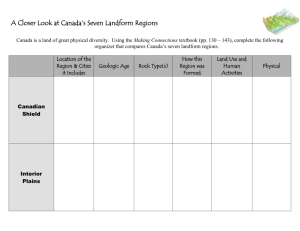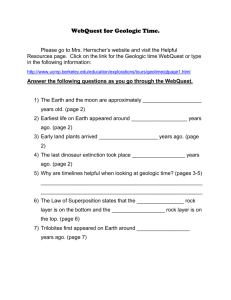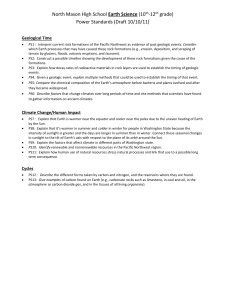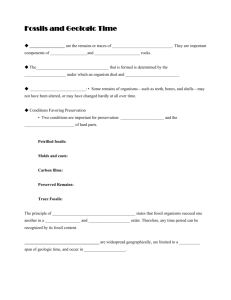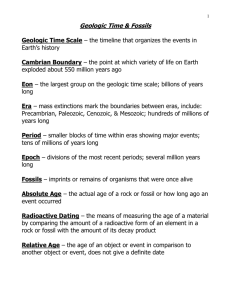LAB # 8
advertisement
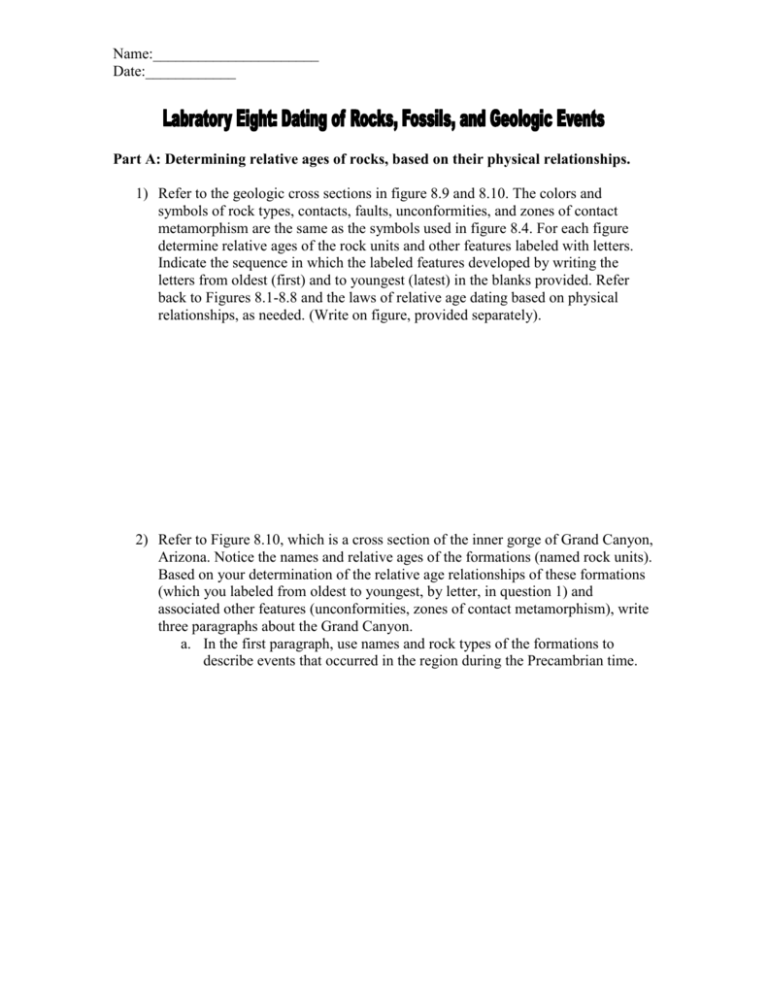
Name:______________________ Date:____________ Part A: Determining relative ages of rocks, based on their physical relationships. 1) Refer to the geologic cross sections in figure 8.9 and 8.10. The colors and symbols of rock types, contacts, faults, unconformities, and zones of contact metamorphism are the same as the symbols used in figure 8.4. For each figure determine relative ages of the rock units and other features labeled with letters. Indicate the sequence in which the labeled features developed by writing the letters from oldest (first) and to youngest (latest) in the blanks provided. Refer back to Figures 8.1-8.8 and the laws of relative age dating based on physical relationships, as needed. (Write on figure, provided separately). 2) Refer to Figure 8.10, which is a cross section of the inner gorge of Grand Canyon, Arizona. Notice the names and relative ages of the formations (named rock units). Based on your determination of the relative age relationships of these formations (which you labeled from oldest to youngest, by letter, in question 1) and associated other features (unconformities, zones of contact metamorphism), write three paragraphs about the Grand Canyon. a. In the first paragraph, use names and rock types of the formations to describe events that occurred in the region during the Precambrian time. b. In the second paragraph, use names and rock types of the formations to describe events that occurred in the region during the Cambrian period of time. c. In the third paragraph, describe what geologic events are occurring at the present time and infer what and where different kinds of unconformities (disconformities, angular unconformity, nonconformity) are forming. 3) Refer to the geologic cross sections in figures 8.11 and 8.12. For each figure, determine the relative ages of rock units and other features labeled with labels. Indicate the sequence in which the labeled features developed by writing the letters from the oldest (first) to the youngest (latest) in the blanks provided. Refer back to figure 8.1-8.8 and the laws of relative age dating based on physical relationships as needed. More then one solution is possible for both of these figures so be able to justify your reasoning. (Write on figure provided separately). Part B: Using fossils to determine age relationships. 4) Analyze the fossiliferous rock in figure 8.14. a. Based on figure 8.13, what is the relative age of the rock in figure 8.14? Explain your reasoning. b. Based on figure 8.13, what is the absolute age of the rock in figure 8.14? Explain your reasoning. 5) Analyze the fossiliferous rock in figure 8.15. a. Based on figure 8.13, what is the relative age of the rock in figure 8.14? Explain your reasoning. b. Based on figure 8.13, what is the absolute age of the rock in figure 8.14? Explain your reasoning. 6) Re-examine the geologic cross section in figure 8.2 on the basis of its fossils. a. Which one of the contacts between lettered layers is a disconformity. b. What is missing at the disconformity? c. If the present landscape in this cross section were covered today with a layer of sediment, then how much time would the resulting disconformity represent? Explain your reasoning. 7) What geologic events occurred during the Mesozoic era in the region where figure 8.3 is located? Explain your reasoning. Part C: Determining absolute ages by radiometric dating. 8) A solidified lava flow containing zircon mineral crystals is present in a sequence of rock layers that are exposed in a hillside. A mass spectrometer analysis was used to count the atoms of Uranium-235 and Lead-207 isotopes in zircon samples from the lava flow. The analysis revealed that 71% of the atoms were Uranium235, and 29% of the atoms were Lead-207. a. About how many half-lives of the Uranium-235 to Lead-207 decay pair have elapsed in the zircon crystals? b. What is the absolute age of the lava flow based on its zircon crystals? Show calculations. c. What is the age of the rock layers beneath the lava flow? d. What is the age of the rock layers above the lava flow? 9) Astronomers think that the Earth probably formed at the same time as all of the other rocky materials in our solar system, including the oldest meteorites. The oldest meteorites ever found on the Earth contained nearly equal parts of both the Uranium-238 and Lead-206. Based on Figure 8.16, what is the Earth’s age? Explain your reasoning. 10) If you assume that the global amount of radiocarbon (formed by cosmic-ray bombardment of atoms in the upper atmosphere and then dissolved in rain and seawater) is constant, then decaying Carbon-14 is continuously replaced in organisms while they are alive. However, when an organism dies, the amount of its Carbon-14 decreases as it decays into Nitrogen-14. a. The Carbon in a buried peat bed has about 6% of the Carbon-14 of modern shells. What is the age of the peat bed? Explain. b. In sampling the peat bed you must be careful to avoid any young plant roots or old limestone. Why? 11) Layers of sand on a New Jersey beach contain common zircon crystals. a. Could the zircon crystals be used to date exactly when the layers of sand were deposited? Explain. b. Suggest a rule that geologists should follow when they date rocks according to radiometric ages of crystals inside the rocks. Part D: Infer the geologic history of two field sites. 12) Refer to figure 8.17. a. What is the relative age of the sedimentary rocks in this rock exposure? Explain. b. What is the absolute age of the sill? Explain c. Locate the fault. How much displacement has occurred along this fault? d. Explain the geologic history of this region, starting with deposition of the sandstone and ending with the time this picture was taken. Use names of relative ages of geologic time and absolute ages in your explanation. Assume the fault occurred after emplacement of the sill. 13) Carefully examine figure 8.18, a surface mine (strip mine) in northern Pennsylvania’s anthracite coal mining district. Describe the age and all the events that have happened to the fossil plants from the time when they were alive to the time when they were exposed by bulldozers. Answers may differ, include a justification. Part E: Construct and interpret a subsurface geologic cross section. 14) What is the nature and geologic origin of the bottom contact of Unit 2? 15) Why is coal not found in wells A and B, whereas two coal seams are found in well E? 16) Wells A and B are dry holes, so-called because they produce no petroleum. But the others produce petroleum. An oil pool is penetrated in well B from 750 feet to 650 feet, in well C from 550 down to 500 feet and in well D from 750 down to 500 feet. Sketch and label the outline of the oil pool on the cross section (on separate sheet, figure 8.19) and explain why the oil is trapped there. 17) Why is there no oil in either well A or B? 18) Using the laws of original horizontality, superposition and cross-cutting (refer back to part A of lab), describe the sequence of events that developed this geologic situation.




